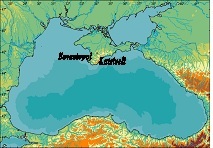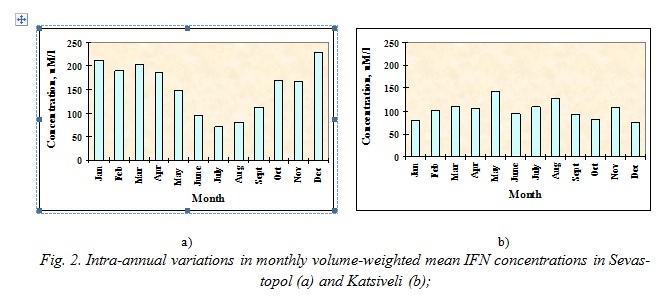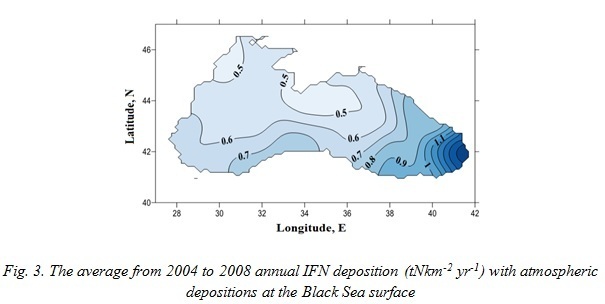Russian Federation
BISAC NAT010000 Ecology
BISAC NAT045050 Ecosystems & Habitats / Coastal Regions & Shorelines
BISAC NAT025000 Ecosystems & Habitats / Oceans & Seas
BISAC NAT045030 Ecosystems & Habitats / Polar Regions
BISAC SCI081000 Earth Sciences / Hydrology
BISAC SCI092000 Global Warming & Climate Change
BISAC SCI020000 Life Sciences / Ecology
BISAC SCI039000 Life Sciences / Marine Biology
BISAC SOC053000 Regional Studies
BISAC TEC060000 Marine & Naval
Atmospheric precipitations can be an important source of nutrients to open and coastal zones of marine ecosystem. Jickells [1] has published that atmospheric depositions can sup-port 5-25% of nitrogen required to primary production. Bulk atmospheric precipitations have been collected in a rural location at the Black Sea Crimean coast – Katsiveli settlement, and an urban location – Sevastopol city. Samples have been analyzed for inorganic fixed nitrogen (IFN) – nitrate, nitrite, and ammonium. Deposi-tions have been calculated at various space and time scales. The monthly volume weighted mean concentration of IFN increases from summer to winter in both locations. A significant local source of IFN has been revealed for the urban location and this source and its spatial influence have been quantified. IFN deposition with atmospheric precipitations is up to 5% of its background content in the upper 10 m layer of water at the north-western shelf of the Black Sea. Considering Redfield C:N ratio (106:16) and the rate of primary production (PP) in coastal areas of the Black Sea of about 100-130 g C m-2 year-1 we have assessed that average atmospheric IFN depositions may intensify primary production by 4.5% for rural locations, but this value is increased many-fold in urban locations due to local IFN sources.
inorganic fixed nitrogen, atmospheric input, the Black Sea
I. Introduction
Atmospheric deposition plays a significant role in forming of the chemical composition and characteristics of surface layer of Black Sea. Indeed, many scientists [2-4] consider atmospheric deposition as one of the most important sources of nutrients and pollutants to marine ecosystems. This is specifically true for conditions of summer stratification [5], when vertical exchange is restricted.
The composition of atmospheric precipitations depends on meteorological conditions, long-range atmospheric transport, local sources to atmosphere and their spatial and temporal distribution [6].
The main disadvantage of analytical determinations of chemical composition of atmospheric deposition is that this monitoring requires great efforts to quantify temporal and spatial features of IFN deposition. Therefore, assessments based on numerical modeling are often applied [7-9]. Yet, chemical composition estimates and meteorological data are still required for these assessments. Such approach helps to quantify: a) background deposition due to long-range atmospheric transport and b) the input of local sources to the composition of atmospheric precipitations.
Nitrogen (nitrate, ammonium) in atmospheric deposition mostly associated with anthropogenic sources: fuel burning, motor vehicle exhaust gas and farming. That is why large cities, industrial and agricultural sites are local sources of IFN, while local meteorological conditions govern their spatial pattern.
Publications on atmospheric deposition of inorganic nitrogen at the surface of the Black Sea have been highly limited until recently. We present and analyze in this work observational data for 263 precipitation events collected at Katsiveli and for 328 precipitation events collected in
II. Materials and methods
2.1. Sampling sites
Monitoring of bulk atmospheric precipitations and analysis of inorganic fixed nitrogen concentrations have been organized in Katsiveli (Southern coast of Crimea) and Sevastopol (Western coast of Crimea) (Fig. 1) from 2003 – 2008 and from 2014-2015.

Katsiveli is located at the sea coast and at a distance from the nearest largest cities which could additionally support nutrients and pollutants to atmosphere and with atmospheric precipitations. Its permanent population does not exceed 550 citizens. Besides, this site is protected by 600–1100m high cliffs from northern and north-western winds, to additionally block urban air pollution. Taking these facts into account, we considered Katsiveli as a background location that characterizes large-scale processes of nutrients migration.
2.2. Sampling and analysis
Of all collected samples, 61% were collected from October to March and 39% - from April to September making possible to trace intra-annual variations.
Using data on the inorganic nitrogen concentration in atmospheric depositions the annual flux of IFN was estimated [10].
Collected samples were analyzed for nitrate+nitrite and ammonium concentrations following standard analytical procedures [11]. The operational reproducibility was 12.5% and accuracy was 20% for nitrate+nitrite, and 3.1% and 9.0% for ammonium. Primary data were quality verified and statistically filtered to eliminate potentially erroneous and/or abnormal results applying the three sigma rule.
Using 2004-2008 IFN data we identified the local source of IFN: its value, seasonal and spatial effects.
Meteorological data were also recorded for the rate of precipitation, wind speed and direction, air temperature, atmospheric pressure and relative humidity making possible statistical and regression analyses.
III. Results and discussions
3.1 Average concentrations and their temporal variations
Atmospheric depositions of IFN in both locations were mainly presented by nitrate (53–66 %) and ammonium (33–45 %). Nitrite was in the range of 1–2% and it presented, most probably, intermediate products of oxidation of ammonium to nitrate. These results are in good agreement with published data [1, 2, 12, 13]
IFN concentrations dropped to their minimum of 22.50 µmol/l and 30.72 µmol/l in September 2014 and September
Data for permanently open and wet-only samplers showed that the flux measured for bulk deposition was only 20% higher.
The monthly volume weighted mean concentrations of IFN in atmospheric precipitations revealed the presence of seasonal oscillations in

Significantly higher concentrations were revealed in
The summer volume-weighted mean concentrations were equal for
The calculated average annual IFN input for urban area (
3.2 Spatial variability of IFN deposition
In order to analyze spatial variations in the IFN input we have followed [15] to parameterize the concentration of trace substances as a function of meteorological variables. Jenkins et al. [18] has demonstrated that nitrate concentrations in rainwater depend on local weather patterns. We have applied a multiple regression equation to bind meteorological parameters (daily data of the precipitations amount, wind direction, season and preceding dry period) with the flow of contaminants from the atmosphere.
The rate of precipitation is the most influential parameter [16] and it is assessed by the power law [7, 17]. The influence of the wind has been approximated by the third or fourth-order power law [20].
In order to reconstruct a multiple nonlinear regression equation for the IFN concentration as a function of meteorological parameters, we have followed the approach suggested by Brandon [21]. The method is based on (i) identification of regressions between the concentration of IFN and individual statistically significant meteorological variables and (ii) successive introduction of these individual regressions to the multiple regression equation.
Four meteorological variables (precipitation rate, wind speed and direction, and relative humidity) have been identified of having relevant and statistically significant influence on the concentration of IFN in samples of rainwater. They have been successively introduced to the multiple non-linear regression equation (1), and their contributions have been evaluated [22].

where Ri is the daily precipitation amount, mm; Vx and Vy are latitudinal and longitudinal wind components; f is relative humidity, %.
The influence of the rate of atmospheric precipitation reaches 68%. The contributions of other components are comparable and equal 12, 10 and 10% for the wind speed, wind direction and relative humidity, respectively.
This equation has been verified against observational data from
Applying (1) to calculate the concentration of IFN in the atmospheric precipitations for regional meteorological conditions and multiplying this concentration by the rate of precipitation, we have quantified inputs of IFN for individual rain events.
The total amount of IFN deposited at the surface of the Black Sea over the period 2004–2008 is about 1.55∙106 t, which is on average about 0.75 t N km-2 yr-1.
Spatial variations mostly depend on the distribution of precipitations over the sea. The rate of atmospheric precipitations [23] increases from the Romanian and Crimean coast to the coast of

The character of seasonal distribution of IFN deposition is similar to variations of the IFN concentration in precipitations: it increases in cold period of the year, but decreases in warm period (Table 1).
Table 1. Seasonal variations in deposition of IFN at the
|
Season |
IFN deposition, t·season-1 (min-max) |
% of the seasonal riverine input |
|
Spring |
46-68 |
16-24 |
|
Summer |
26-38 |
13-19 |
|
Autumn |
90-103 |
70-80 |
|
Winter |
75-81 |
40-44
|
3.3 Local source
The difference between winter volume-weighted mean concentrations in rural and urban locations may indicate the local source of IFN to atmosphere. Taking into account that there is no difference for summer period, we conclude that this local source is most important in the cold period of the year. This local source is expected for every large city at the Black Sea coast (
To assess the extent of its influence we have followed [14]:

where Cj is the maximum concentration of ingredient near the source (mg l-1); λj is the coefficient characterizing the rate of changing concentration (km-1).
The value of λj depends on the aerosol composition, wind speed and wind direction. For an average wind speed of about

where k is the coefficient specific for the aerosol composition (for example, k=0.35 for nitrate and ammonium); η is the wind direction frequency in %.
We have found that the effect of local source associated with large cities for typical conditions of
The total amount of IFN deposited at the surface of the
Considering that 25-km coastal area near
Despite the fact that local sources have no significant direct effect on off-shore areas of the sea, monitoring of IFN deposition remains important to correctly evaluate the budget of nitrogen in coastal waters near industrial sites. It is specifically true for winter, when these sources are most significant.
3.4 Influence on primary production
To asses influence of nitrogen atmospheric depositions to marine primary production (PP) many scientists [24-27] apply the Redfield C:N ratio (106:16).
We have assessed that average annual flux of IFN in coastal zone is about 53.6 mmol m-2 and may contribute of increasing the value of PP on by 355.1 mmol m-2 or
IV. Conclusions
Atmospheric deposition of IFN in two sites (urban and rural) of Crimean coast of the
The summer volume-weighted mean concentrations are equal in
The calculated average annual IFN input for urban area (
A significant local source of IFN has been revealed for the urban location. The effect of local source associated with large cities for typical conditions of
Spatial variations of IFN deposition are mostly governed by the distribution of precipitations over the sea: increases from the Romanian and Crimean coast to the coast of
The average atmospheric IFN depositions may result in additional PP of 3.3-4.3% for rural locations, but this value is increased many-fold due to the influence of local sources in urban locations.
This work has been partially supported from RFBR project #14-45-01008 for A. Varenik and from RFBR project #14-45-01001 for S. Konovalov.
1. Jickells, T. 1995. Atmospheric inputs of metals and nutrients to the oceans: Their magni-tude and effects. Mar. Chem. 48: 199-214.
2. Guerzoni S, Chester R, Dulac F, Herut B, Loÿe-Pilot MD, et al. (1999) The role of at-mospheric deposition in the biogeochemistry of the Mediterranean Sea. Progress in Oceanography 44: 147-190. doi:https://doi.org/10.1016/s0079-6611(99)00024-5.
3. Béthoux, J. P., P. Morin, and D. P. Ruiz-Pino, Temporal trends in nutrient ratios: chemical evidence of Mediterranean ecosystem changes driven by human activity, Deep-Sea Res. II, 49 (11), 2007-2016, 2002.
4. Christodoulaki S, Petihakis G, Kanakidou M, Mihalopoulos N, Tsiaras K, Triantafyllou G. Atmospheric deposition in the eastern Mediterranean. A driving force for ecosystem dynamics. J. Mar. Syst. 2013;109-110:78-93.
5. Markaki, Z., Oikonomou, K., Kocak, M., Kouvarakis, G., Chaniotaki, A., Kubilay, N., Mihalopoulos, N., 2003. Atmospheric deposition of inorganic phosphorus in the Levan-tine Basin, eastern Mediterranean: spatial and temporal variability and its role in seawater productivity. Limnology and Oceanography 48, 1557-1568.
6. N. Durana, H. Casado, A. Ezcurra, C. Garcia, J.P. Lacaux, Pham Van Dinh Experimental study of the scavenging process by means of a sequential precipitation collector, prelimi-nary results. Atmospheric Environment. Part A. General Topics, Volume 26, Issue 13, Pages 2437-2443.
7. Beverland, I. J., Crowther, J. M., Srinivas, M. S. N., and Heal, M. R.: The influence of meteorology and atmospheric transport patterns on the chemical composition of rainfall in south-east England, Atmos. Environ., 6, 1039-1048, 1998.
8. Àvila, A., Alarcón, M., 1999. Relationship between precipitation chemistry and meteoro-logical situations at a rural site in NE Spain. Atmospheric Environment., 33, 1663-1677.
9. Celle -Jeanton, H., Travi, Y., Loye-Pilot, M.D., Huneau, F., Bertrand, G.: Rainwater chemistry at a Mediterranean inland station (Avignon, France): local contribution versus long range supply. Atmospheric Research 91, 118-126 (2009).
10. Varenik, A. V., Konovalov, S. K., and Metik-Diyunova, V. V.: Temporal and spatial var-iations in the influence of atmospheric precipitation on the distribution of inorganic fixed nitrogen in the Black Sea surface waters (Prostranstvennoe raspredelenie potoka neorganicheskogo azota s atmosfernimi osadkami na poverhnost Chernogo morya), in: Ecological Safety of Coastal and Shelf Zones and Comprehensive Use of Shelf Resources: Collected Scientific Papers, Iss. 22, edited by: Ivanov, V. A., NAS of Ukraine, MHI, IGS, OD IBSS, Sevastopol, 268-273, 2010..
11. Berg, T., Dye, C., Hanssen, J. E., Munthe, J., Putaud, J.-P., Reissell, A., Schaug, J., Schmidbauer, N., Semb, A., Torseth, K., Uggerud, H. T., Yttri, K. E., and Aas, W.: EMEP manual for sampling and chemical analysis, EMEP/CCC-Report 1/95, NILU, Kjeller, Norway, November, 2001.
12. Koçak, M., Kubilay, N., Tuğrul, S., and Mihalopoulos, N.: Atmospheric nutrient inputs to the northern levantine basin from a long-term observation: sources and comparison with riverine inputs, Biogeosciences, 7, 4037-4050, doihttps://doi.org/10.5194/bg-7-4037-2010, 2010.
13. Medinets, S., Medinets, V., 2012. Investigations of atmospheric wet and dry nutrient deposition to marine surface in western part of the Black Sea. Turk. J. Fish. Aquat. Sci. 12, 497-505.
14. Izrael, Y. A., Nazarov, I. M., Fridman, S. D., Galperin, M. V., Pressman A, Y., Ryaboshapko, A. G., Vitkov, C. D., Gaspra, L., Harvath, L., Disher, H., Damrat, U., Zavodski, V., and Shantroch, Y.: Monitoring of the Transboundary Air Pollutant Transport, Hydrometeoizdat, Leningrad, 1987 (in Russian).
15. Vautz, W., Busch, A. U., Urfer, W., and Klockow, D.: A statistical approach to estimate spatial distributions of wet deposition in Germany, Water Air Soil Poll., 145, 215-238, doihttps://doi.org/10.1023/A:1023676011565, 2003.
16. Sweet, S., Wade, T. L., Park, J., and Wylie, D.: Atmospheric deposition of nutrient nitro-gen to Galveston Bay, Texas, in: Proceedings, Galveston Bay Estuary Program, State of the Bay Symposium IV, 28-29 January, Galveston, TX, 263-274, 1999.
17. Garban, B., Motelay-Massei, A., Blanchoud, H., and Ollivon, D.: A single law to describe atmospheric nitrogen bulk deposition versus rainfall amount: inputs at the Seine River watershed scale, Water Air Soil Poll., 155, 339-354, 2004.
18. Jenkins, S., Gamble, D., Benedetti, M., and Willey, J.: The effects of local weather pat-terns on nitrate and sulfate rainwater concentrations in Wilmington, North Carolina, The North Carolina Geographer, 14, 29-38, 2006.
19. Padgett, P. E. and Minnich, R. A.: Wet deposition of nitrogenous pollutants and the effect of storm duration and wind direction: a case study from inland Southern California, Water Air Soil Poll. 187, 337-341, 2008.
20. Abesalashvili, L., Supatashvili, G., Salukvadze, T., and Salukvadze, M.: Hydrochemical characteristic of atmospheric precipitation in the Alazani Valley, Journal of the Georgian Geophysical Society, ISSN 1512-1127, Issue (B), Physics of Atmosphere, Ocean and Space Plasma, Geoprint, Publishing House, Tbilisi,vol. 5B, 56-62, 2001.
21. Brandon, D. B.: Developing mathematical models for computer control, Instrument Soci-ety of America Journal, 7, 176-203, 1959.
22. Varenik, A., Konovalov, S., and Stanichny, S.: Quantifying importance and scaling effects of atmospheric deposition of inorganic fixed nitrogen for the eutrophic Black Sea, Biogeosciences, 12, 6479-6491, doihttps://doi.org/10.5194/bg-12-6479-2015, 2015.
23. Ivanov, V. A. and Belokopytov, V. N.: Oceanography of the Black Sea, ECOSY-Gidrofizika, Sevastopol, 17-19, 2013.
24. Herut B., Krom M.D., Pan, G., Mortimer, R. Atmospheric input of nitrogen and phospho-rus to the Southeast Mediterranean: Sources, fluxes, and possible impact // Limnology and Oceanography.- 1999.- 44(7).- R.1683-1692. doihttps://doi.org/10.4319/lo.1999. 44.7.1683.
25. Krishnamurthy, A., Moore, J. K., Mahowald, N., Luo, C., and Zender, C. S.: Impacts of atmospheric nutrient inputs on marine biogeochemistry, J. Geophys. Res., 115, G01006, doihttps://doi.org/10.1029/2009JG001115, 2010.
26. Orens Pasqueron de Fommervault, Christophe Migon, Aurélie Dufour, Fabrizio D'Ortenzio, Fayçal Kessouri, Patrick Raimbault, Nicole Garcia, Véronique Lagadec, At-mospheric input of inorganic nitrogen and phosphorus to the Ligurian Sea: Data from the Cap Ferrat coastal time-series station, Deep Sea Research Part I: Oceanographic Research Papers, 2015, 106, 116.
27. Tugrul, S., Murray, J. W., Friederich, G. E., and Salihoglu, L.: Spatial and temporal vari-ability in the chemical properties of the oxic and suboxic layers of the Black Sea, J. Mar. Sys., 135, 29-43, 2014.
28. M. Koçak, N. Mihalopoulos, E.Tutsak, P. Kalegeri. Atmospheric Deposition of Macro Nutrients (DIN and DIP) onto the Black Sea and Implications on Marine Productivity. Journal of the Atmospheric Sciences 02/2016; 73(4):160203133541003. DOIhttps://doi.org/10.1175/JAS-D-15-0039.1
29. Demidov A.B. (2008). Seasonal dynamics and estimation of the annual primary produc-tion of phytoplankton in the Black Sea. Oceanology, 48: 664-678. doi:https://doi.org/10.1134/s0001437008050068.







